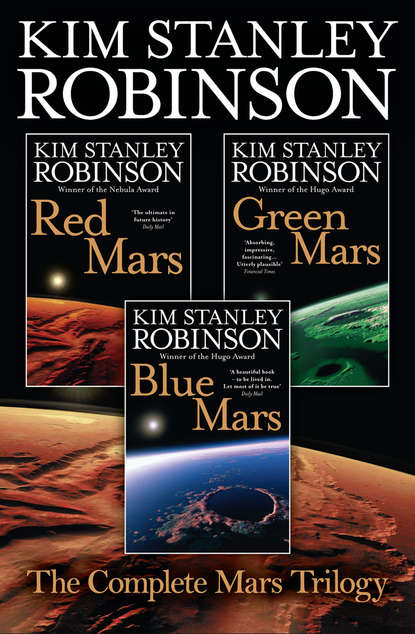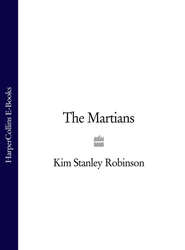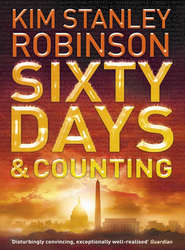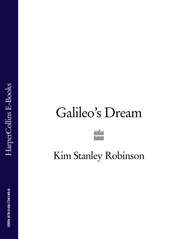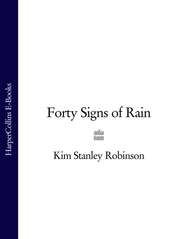По всем вопросам обращайтесь на: info@litportal.ru
(©) 2003-2025.
✖
The Complete Mars Trilogy: Red Mars, Green Mars, Blue Mars
Автор
Год написания книги
2018
Настройки чтения
Размер шрифта
Высота строк
Поля
Hiroko stopped chanting, brought her hand to her mouth, began to eat the dirt in her palm. All the others did the same. Michel lifted his hand to his face: a lot of dirt to eat, but he stuck his tongue out and licked up half of it and felt a brief electric shiver as he rubbed it against the roof of his mouth, sliding the gritty stuff back and forth until it was mud. It tasted salty and rusty, with an unpleasant whiff of rotten eggs and chemicals. He choked it down, gagging slightly. He swallowed the other mouthful in his hand. There was an irregular hum coming from the circle of celebrants as they ate, vowel sounds shifting from one to the next, aaaay, ooooo, ahhhh, iiiiiii, eeee, uuuuuu, lingering over each vowel for a minute it seemed, the sound spreading into two and sometimes three parts, with head tones creating odd harmonies. Hiroko began to chant over this song. Everyone stood and Michel scrambled up with them. They all moved into the center of the circle together, Evgenia and Ellen taking Michel by the arms and pulling him along. Then they were all pressed together around Hiroko, in a mass of close-packed bodies, surrounding Michel so that warm skin squashed up against every side of him. This is our body. A lot of them were kissing, their eyes closed. Slowly they moved, twisting to keep maximum contact as they shifted to new kinetic configurations. Wiry pubic hair tickled his bottom, and he felt what had to have been an erect penis against his hip. The dirt was heavy in his stomach, and he felt light-headed; his blood was fire, his skin felt like a taut balloon, containing a blaze. The stars were packed overhead in astonishing numbers, and each one had its own color, green or red or blue or yellow; they looked like sparks.
He was a phoenix. Hiroko herself pressed against him, and he rose in the center of the fire, ready for rebirth. She held his new body in a full embrace, squeezed him; she was tall, and seemed all muscle. She looked him eye-to-eye. He felt her breasts against his ribs, her pubic bone hard on his thigh. She kissed him, her tongue touching his teeth; he tasted the dirt, then suddenly felt all of her at once; all the rest of his life the involuntary memory of that feeling would be enough to start the pulse of an erection, but at that moment he was too overwhelmed, completely aflame.
Hiroko pulled her head back and looked at him again. His breath was whooshing in his lungs, in and out. In English, in a voice formal but kind, she said, “This is your initiation into the areophany, the celebration of the body of Mars. Welcome to it. We worship this world. We intend to make a place for ourselves here, a place that is beautiful in a new Martian way, a way never seen on Earth. We have built a hidden refuge in the south, and now we are leaving for it.
“We know you, we love you. We know we can use your help. We know you can use our help. We want to build just what you are yearning for, just what you have been missing here. But all in new forms. For we can never go back. We must go forward. We must find our own way. We start tonight. We want you to come with us.”
And Michel said, “I’ll come.”
PART FIVE Falling Into History (#ulink_912ecfcd-3160-5cc0-9c46-7d9280668d3a)
The lab hummed quietly. Desks and tables and benches were cluttered with things, the white walls crowded with graphs and posters and cut-out cartoons, all vibrating slightly under bright artificial light. Like any lab anywhere: somewhat clean, somewhat disorderly. The one window in the corner was black and reflected the interior; it was night outside. The whole building was nearly empty.
But two men in lab coats stood at one of the benches, leaning forward to look at a computer screen. The shorter of the two tapped at the keyboard below the screen with a forefinger, and the image on the screen changed. Green corkscrews on a black field, squiggling so that they looked sharply three dimensional, as if the screen were a box. An image from an electron microscope; the field was only a few microns across.
“You see it’s a kind of plasmid repair of the gene sequence,” the short scientist said. “Breaks in the original strands are identified. Replacement sequences are synthesized, and when these replacement sequences are introduced into the cell, the breaks are seen as attachment sites, and the replacements bind to the originals.”
“Do you introduce them by transformation? Electroporation?”
“Transformation. Treated cells are injected along with a competent, and the repair strands make a conjugal transfer.”
“In vivo?”
“In vivo.”
A low whistle. “So you can repair any little thing? Cell division error?”
“That’s right.”
The two men stared at the corkscrews on the screen, waving about like the new tips of grapevines in a breeze.
“You’ve got proof?”
“Did Vlad show you those mice in the next room?”
“Yeah.”
“Those mice are fifteen years old.”
Another whistle.
They went next door into the mice room, muttering to each other under the hum of machinery. The tall one stared curiously into a cage, where patches of fur breathed under wood chips. When they left again they turned out the lights in both rooms. The flicker of the electron microscope screen illuminated the first lab, giving it a green cast. The scientists went to the window, talking in low voices. They looked out. The sky was purple with the coming day; stars were popping out of existence. Out on the horizon stood a black massive bulk, the flat-topped mound of an immense volcano. Olympus Mons, the largest mountain in the solar system.
The tall scientist shook his head. “This changes everything, you know.”
“I know.”
From the bottom of the shaft, the sky looked like a bright pink coin. The shaft was round, a kilometer in diameter, seven kilometers deep. But from the bottom it seemed much thinner and deeper than that. Perspective plays a lot of tricks on the human eye.
Such as that bird, flying down the round pink dot of the sky, looking so big. Except it wasn’t a bird. “Hey,” John said. The shaft director, a round-faced Japanese named Etsu Okakura, looked at him, and through their two faceplates John could see the man’s nervous grin. One of his teeth was discolored.
Okakura looked up. “Something falling!” he said quickly, and then: “Run!”
They turned and ran over the shaft floor. Quickly John found that although most of the loose rock had been swept off the starred black basalt, no effort had been made to make the shaft bottom perfectly level. Miniature craters and scarps became increasingly difficult as he gained speed; in this moment of primate flight the instincts formed in childhood reasserted themselves, and he kept pushing off too hard with each step, coming down on uninspected terrain with a jolt and then pushing off wildly again, a crazy run until finally he caught his toe and lost control and fell crashing across the ragged stone, arms flung out to save his faceplate. It was small comfort to see that Okakura had fallen as well. Fortunately the same gravity that had caused their tumbles was giving them more time to escape: the falling object had not yet landed. They got up and ran again, and once again Okakura fell. John glanced back and saw a bright metallic blur hit the rock, and then the sound of the impact was a solid whump, like a blow. Silver bits splashed away, some in their direction: he stopped running, scanned the air for incoming ejecta. No sound at all.
A big hydraulic cylinder flew out of the air and banged end over end to their left, and they both jumped. He hadn’t seen it coming.
After that, stillness. They stood nearly a minute, and then Boone stirred. He was sweating; they were in pressurized suits, but at 49°C the shaft bottom was the hottest place on Mars, and the suit’s insulation was built for cold. He made a move to help Okakura to his feet, but stopped himself; presumably the man would rather get up himself than owe giri to Boone for the help. If Boone understood the concept properly. “Let’s have a look,” he said instead.
Okakura got up, and they walked back over the dense black basalt. The shaft had long ago been bored into solid bedrock, in fact it was now about twenty percent of the way through the lithosphere. It was stifling at the bottom, as if the suits were entirely uninsulated. Boone’s air supply was a welcome coolness in the face and lungs. Framed by the dark shaft walls, the pink sky above was very bright. Sunlight illuminated a short conic section of the shaft wall. In midsummer the sun might shine all the way – no, they were south of the Tropic of Capricorn. In shadow forever, down here.
They approached the wreck. It had been a robot dump truck, hauling rock up the road that cut a spiral into the shaft wall. Pieces of the truck were mixed with big rough boulders, some scattered as much as a hundred meters from the point of impact. Beyond a hundred meters debris was rare; the cylinder that had flown by them must have been fired out under pressure of some kind.
A pile of magnesium, aluminum and steel, all twisted horribly. The magnesium and aluminum had partially melted. “Do you think it fell all the way from the top?” Boone asked.
Okakura didn’t respond. Boone glanced at him; the man was studiously avoiding his gaze. Perhaps he was frightened. Boone said, “There must have been a good thirty seconds between the time I caught sight of it and when it hit.”
At roughly three meters per second squared, that had been more than enough time for it to reach terminal velocity. So it had hit at about two hundred kilometers per hour. Not so bad, really. On Earth it would have come down in less than half the time, and might have caught them. Hell, if he hadn’t have looked up when he had, this one might have caught them. He made a quick calculation. It had probably been about halfway up the shaft when he saw it. But at that point it could have been falling for quite some time.
Boone slowly walked around into the gap between the shaft wall and the pile of scrap. The truck had landed on its right side, and the left side was deformed but recognizable. Okakura climbed several steps up the wreckage, then pointed at a black area behind the left front tire. John followed him up, scraped at the metal with the claw on his right glove’s forefinger. The black came away like soot. Ammonium nitrate explosion. The body of the truck was bent in there as if hammered. “A good-sized charge,” John observed.
“Yes,” Okakura said, and cleared his throat. He was frightened, that was sure. Well, the first man on Mars had almost been killed while in his care; and himself too, of course, but who knew which would scare him more? “Enough to push truck off road.”
“Well, like I said, there’s been some sabotage reported.”
Okakura was frowning through his faceplate. “But who? And why?”
“I don’t know. Anyone in your team seem to be having any psychological difficulties?”
“No.” Okakura’s face was carefully blank. Every group larger than five had someone experiencing difficulties, and Okakura’s little industrial town had a population of five hundred.
“This the sixth case I’ve seen,” John said. “Although none so close up.” He laughed. The image of the birdlike dot in the pink sky came back to him. “It would have been easy for someone to attach a bomb to a truck before it came down. Detonate it with a clock or an altimeter.”
“Reds, you mean.” Okakura was looking relieved. “We have heard of them. But it is …” He shrugged. “Crazy.”
“Yes.” John climbed gingerly off the wreck. They walked back across the floor of the shaft to the car they had come down in. Okakura was on another band, talking to people up top.
John stopped by the central pit to have a final look around. The sheer size of the shaft was hard to grasp: the muted light and vertical lines reminded him of a cathedral, but all the cathedrals ever built would have sat like dollhouses at the bottom of this great hole. The surreal scale made him blink, and he decided he had tilted his head back too long.
They drove up the road inscribed in the side wall to the first elevator, left the car and got in the cage. Up they went. Seven times they had to get out and walk across the wall road to the bottom of the next elevator. The ambient light grew to something more like ordinary daylight. Across the shaft he could see where the wall was scored by the double spiral of the two roads: thread-marks in an enormous screw hole. The shaft’s bottom had disappeared into the murk, he couldn’t even make out the truck.
In the last two elevators they ascended through regolith; first the megaregolith, which looked like cracked bedrock, and then the regolith proper, its rock and gravel and ice all hidden behind a concrete retainer, a smooth curved wall that looked like a dam, and was angled so far back that the final elevator was actually a cog rail train. They cranked up the side of this enormous funnel – Big Man’s bathtub drain, Okakura had said on the way down – and came finally to the surface, out into the sun.
Boone got out of the cog train and looked back down. The regolith retainer looked like the inner wall of a very smooth crater, with a two-laned road spiraling down it; but the crater had no floor. A mohole. He could see down the shaft a little way, but the wall was in shadow, and only the road spiraling down picked up any light, so that it appeared to be something like a freestanding staircase, descending through empty space to the planet’s core.
Three of the giant dump trucks ground slowly up the last stretch of the road, full of black boulders. These days it took them five hours to make the trip from the bottom of the shaft, Okakura said. Very little supervision, like most of the project, in both manufacture and operation. The inhabitants of the town only had to see to programming, deployment, maintenance, and troubleshooting. And, now, security.
The town, called Senzeni Na, was scattered over the floor of Thaumasia Fossae’s deepest canyon. Nearest to the hole was the industrial park; here most of the excavation equipment was manufactured, and the rock from the hole processed for its trace amounts of valuable metals. Boone and Okakura stepped into the rim station, changed out of their pressure suits into coppery jumpers, and entered one of the clear walktubes that connected all the buildings in the town. It was cold and sunny in the tubes, and everyone in them wore clothing with an outer layer of copper-colored foil, the latest in Japanese radproofing. Copper creatures, moving in clear tubes; it looked to Boone like a giant ant farm. Overhead the thermal cloud frosted into existence and shot up like steam from a valve, until it was caught by high winds and blown out in a long flattened contrail.





